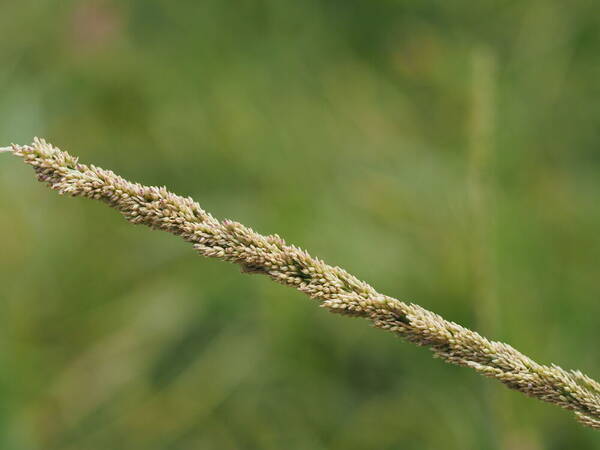Info
Subfamily: Chloridoideae
Genus etymology: Sporobolus = "seed thrower" referring to the seed being ejected from the pericarp
Species etymology: fertilis = "fruitful" [Latin] refering to its production of abundant seeds
Photosynthetic type: C4 (warm season)
Nativity: naturalized - accidental
First recorded in Hawaiʻi: 1936
Map


Inflorescence














Plant


Habit



Spikelets






Description
Perennial. Culms densely tufted, erect, rigid, 25–100(–120) cm tall. Leaf sheaths glabrous but margin ciliolate, basal sheaths papery, lightly keeled; leaf blades linear, flat or involute, 15–50(–65) × 0.2–0.5 cm, glabrous or adaxial surface thinly pilose, tapering to a long filiform apex; ligule ca. 0.5 mm. Panicle linear, contracted to spikelike, often interrupted especially at base, 7–45 × 0.5–1.5 cm; branches 1–2.5(–5) cm, erect and appressed to main axis, or looser and narrowly ascending, densely spiculate throughout. Spikelets grayish or yellowish green, 1.7–2 mm; lower glume oblong, ca. 0.5 mm, veinless, apex truncate-erose; upper glume oblong-elliptic, 1/2–2/3 spikelet length, 1- veined, ± acute; lemma ovate, as long as spikelet, indistinctly 1(–3)-veined, acute. Anthers 3, 0.8–1 mm. Grain red-brown, obovate-elliptic, 0.9–1.2 mm, distinctly shorter than its lemma and palea, these gaping widely beyond its top, apex truncate. Fl. and fr. Mar–Dec. 2n = 36, 48, 54.
(Description source: Wu, Z.Y., Raven, P.H. & Hong, D.Y. (eds.). 2006. Flora of China. Volume 22. Poaceae. Missouri Botanical Garden Press, St. Louis. 733 pp. )
Habit Perennial; caespitose. Butt sheaths scarious. Culms erect; 90-160 cm long; 2-5 mm diam. Ligule a fringe of hairs. Leaf-blades flat, or convolute; 25-50 cm long; 3-5 mm wide. Leaf-blade apex attenuate. Inflorescences Inflorescence a panicle. Panicle open; linear; 15-35 cm long; 1-2 cm wide; contracted about primary branches. Primary panicle branches appressed, or ascending; 2-4 cm long; bearing spikelets almost to the base. Panicle branches stiff; glabrous in axils. Spikelets solitary. Fertile spikelets pedicelled. Pedicels linear. Spikelets Spikelets comprising 1 fertile florets; without rhachilla extension. Spikelets lanceolate; subterete; 1.7-2 mm long; breaking up at maturity; disarticulating below each fertile floret. Fertile Spikelets comprising 1 fertile florets; without rhachilla extension. Spikelets lanceolate; subterete; 1.7-2 mm long; breaking up at maturity; disarticulating below each fertile floret. Glume Glumes deciduous; similar; shorter than spikelet; thinner than fertile lemma. Lower glume oblong; 0.4 mm long; 0.5 length of upper glume; without keels; 0 -veined. Lower glume lateral veins absent. Lower glume apex truncate. Upper glume oblong; 1 mm long; 0.5 length of adjacent fertile lemma; hyaline; without keels; 1 -veined. Upper glume lateral veins absent. Upper glume apex obtuse, or acute. Florets Fertile lemma ovate; 1.7-2 mm long; membranous; without keel; 1 -veined. Lemma apex acute. Palea 1 length of lemma; 2 -veined. Palea keels approximate. Flowers Anthers 3; 0.7 mm long. Fruits Caryopsis with free soft pericarp; obovoid; exposed between gaping lemma and palea at maturity; 0.8-1 mm long; truncate. Distribution Asia-temperate: Caucasus, China, and eastern Asia. Asia-tropical: India, Indo-China, Malesia, and Papuasia. Australasia: Australia. Pacific: southwestern, south-central, and northwestern.
(Description source: Clayton, W.D., Vorontsova, M.S., Harman, K.T. and Williamson, H. (2006 onwards). GrassBase - The Online World Grass Flora. Available at https://powo.science.kew.org )